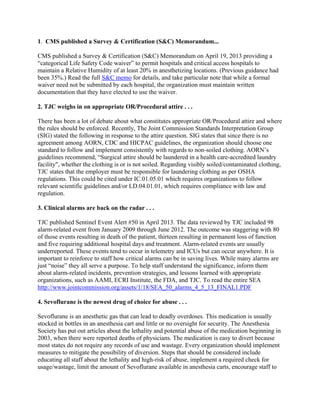
Were You Aware?
- 1. 1. CMS published a Survey & Certification (S&C) Memorandum... CMS published a Survey & Certification (S&C) Memorandum on April 19, 2013 providing a “categorical Life Safety Code waiver” to permit hospitals and critical access hospitals to maintain a Relative Humidity of at least 20% in anesthetizing locations. (Previous guidance had been 35%.) Read the full S&C memo for details, and take particular note that while a formal waiver need not be submitted by each hospital, the organization must maintain written documentation that they have elected to use the waiver. 2. TJC weighs in on appropriate OR/Procedural attire . . . There has been a lot of debate about what constitutes appropriate OR/Procedural attire and where the rules should be enforced. Recently, The Joint Commission Standards Interpretation Group (SIG) stated the following in response to the attire question. SIG states that since there is no agreement among AORN, CDC and HICPAC guidelines, the organization should choose one standard to follow and implement consistently with regards to non-soiled clothing. AORN’s guidelines recommend, “Surgical attire should be laundered in a health care-accredited laundry facility", whether the clothing is or is not soiled. Regarding visibly soiled/contaminated clothing, TJC states that the employer must be responsible for laundering clothing as per OSHA regulations. This could be cited under IC.01.05.01 which requires organizations to follow relevant scientific guidelines and/or LD.04.01.01, which requires compliance with law and regulation. 3. Clinical alarms are back on the radar . . . TJC published Sentinel Event Alert #50 in April 2013. The data reviewed by TJC included 98 alarm-related event from January 2009 through June 2012. The outcome was staggering with 80 of those events resulting in death of the patient, thirteen resulting in permanent loss of function and five requiring additional hospital days and treatment. Alarm-related events are usually underreported. These events tend to occur in telemetry and ICUs but can occur anywhere. It is important to reinforce to staff how critical alarms can be in saving lives. While many alarms are just “noise” they all serve a purpose. To help staff understand the significance, inform them about alarm-related incidents, prevention strategies, and lessons learned with appropriate organizations, such as AAMI, ECRI Institute, the FDA, and TJC. To read the entire SEA http://www.jointcommission.org/assets/1/18/SEA_50_alarms_4_5_13_FINAL1.PDF 4. Sevoflurane is the newest drug of choice for abuse . . . Sevoflurane is an anesthetic gas that can lead to deadly overdoses. This medication is usually stocked in bottles in an anesthesia cart and little or no oversight for security. The Anesthesia Society has put out articles about the lethality and potential abuse of the medication beginning in 2003, when there were reported deaths of physicians. The medication is easy to divert because most states do not require any records of use and wastage. Every organization should implement measures to mitigate the possibility of diversion. Steps that should be considered include educating all staff about the lethality and high-risk of abuse, implement a required check for usage/wastage, limit the amount of Sevoflurane available in anesthesia carts, encourage staff to
- 2. immediately report any concerns of substance abuse and provide substance abuse counseling. It is highly encouraged that you share this article with all staff where this anesthetic is available. 5. Shipping boxes in the kitchen area . . . The Joint Commission, in the October 2011 edition of “Environment of Care News,” indicated that organizations should only permit cardboard shipping boxes in patient care organizations after an appropriate risk assessment is conducted. It has recently been affirmed that “patient care areas” would include kitchen storage and refrigerator areas. References: TJC Comprehensive Accreditation Manual for Hospitals, 2013 TJC (2013). Sentinel event alert issue 50: Medical device alarm safety in hospitals. Retrieved from http://www.jointcommission.org/assets/1/18/SEA_50_alarms_4_5_13_FINAL1.PDF. Anesthesia Blog (2010). Stolen anesthetic vapors. Retrieved from http://theanesthesiaconsultant.com/2010/08/23/stolen-anesthetic-vapors/. The Joint Commission Environment of Care News, October 2011